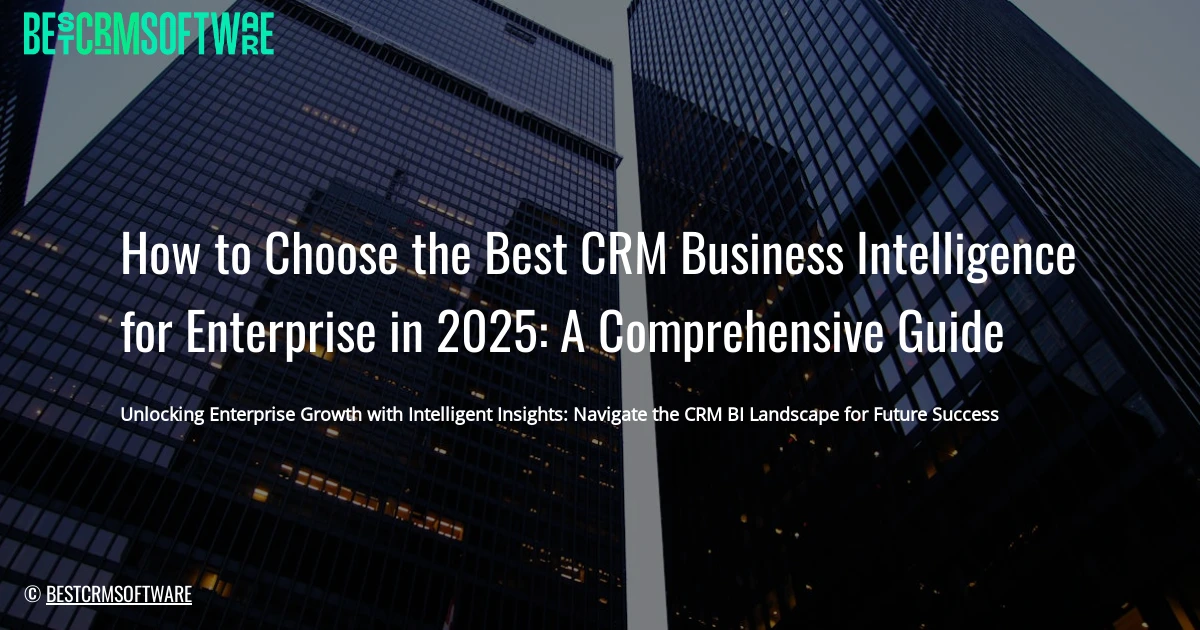Unlocking Enterprise Growth with Intelligent Insights: Navigate the CRM BI Landscape for Future Success
Define Your Enterprise Needs
Choosing the right CRM business intelligence solution is not a one-size-fits-all endeavor. Before embarking on your search, it’s critical to understand your unique business context and aspirations. This requires a deep dive into your enterprise’s specific needs and objectives.
1. Define Your Specific Business Intelligence Needs and Objectives for 2025 and Beyond:
- What data-driven insights do you need to achieve your strategic goals?
- Are you looking to improve customer engagement, optimize marketing campaigns, personalize the customer experience, enhance sales forecasting, or streamline internal operations?
- What specific challenges are you trying to solve with BI?
- For example, are you facing difficulties with customer churn, lead qualification, sales pipeline management, or understanding market trends?
- How will business intelligence contribute to your long-term vision and growth?
- Are you aiming for expansion into new markets, developing innovative products and services, or improving customer retention rates?
2. Identify Key Performance Indicators (KPIs) Aligned with Your Enterprise Goals:
- What are the measurable metrics that reflect your success in achieving your business objectives?
- KPIs should be specific, measurable, achievable, relevant, and time-bound (SMART).
- How will you track these KPIs and measure their progress over time?
- Identifying your critical metrics upfront will guide your search for a CRM BI solution capable of providing meaningful data visualizations and actionable insights.
3. Consider Your Industry, Size, and Growth Projections:
- What are the unique challenges and opportunities specific to your industry?
- For instance, businesses in e-commerce, healthcare, or finance may require specialized data analysis capabilities tailored to their sector.
- What is your current size and projected growth rate?
- Different CRM BI solutions cater to businesses of various scales, from small and medium enterprises (SMEs) to large multinational corporations.
- What are your budget and resource constraints?
- Consider the cost of the solution, implementation, training, and ongoing support when making your selection.
By diligently defining your needs, objectives, KPIs, and the broader business context, you will have a clear roadmap for selecting a CRM BI solution that precisely meets your enterprise’s requirements in 2025 and beyond. This comprehensive understanding will pave the way for a strategic, data-driven journey toward sustainable growth and success.
CRM with BI vs. Specialized BI Tools
When selecting a BI solution for your enterprise in 2025, the choice between CRM systems with integrated BI capabilities and dedicated BI tools presents a key decision point.
CRM with integrated BI capabilities offer a streamlined approach, providing comprehensive insights within your existing CRM platform. This includes:
- Salesforce: With Salesforce Einstein Analytics, you can leverage its powerful AI and machine learning algorithms to analyze data and gain insights into sales performance, customer behavior, and more.
- Microsoft Dynamics 365: Power BI is seamlessly integrated into Dynamics 365, allowing for robust reporting and dashboards across your sales, marketing, and customer service operations.
- Oracle CX: Oracle Analytics Cloud offers real-time insights and advanced data visualization tools directly within the Oracle CX platform, providing a complete view of customer interactions and business performance.
Specialized BI tools are designed specifically for data analysis and visualization, providing flexibility and deeper customization options when integrating with your existing CRM.
- Tableau: This powerful BI platform allows for highly interactive and engaging dashboards, making it ideal for presenting complex data in an accessible way.
- Power BI: Offers a broad range of data connectors, enabling you to connect with multiple data sources, including your CRM, for a more comprehensive data analysis.
- Qlik: Known for its user-friendly interface and advanced data discovery capabilities, Qlik can help your team uncover hidden patterns and relationships in your CRM data.
Ultimately, the best choice for your business depends on your specific needs and priorities:
Consider a CRM with integrated BI if:
- You prefer a unified solution within your existing CRM ecosystem.
- You prioritize ease of use and integration with minimal additional setup.
- You require basic insights and dashboards focused on sales performance.
Consider specialized BI tools if:
- You need highly customized visualizations and advanced analytical capabilities.
- You require integration with diverse data sources beyond your CRM.
- You have a dedicated data analysis team with advanced technical skills.
By understanding the strengths and weaknesses of each approach, you can make an informed decision about the best CRM and BI combination for your enterprise in 2025.

© Philipp Birmes
Intuitive Data Visualization: Unlocking Insights with Ease
The ability to transform raw data into actionable insights is crucial for any enterprise CRM system. This is where intuitive data visualization shines. While powerful analytical tools are essential, the value of a CRM lies in its ability to make complex data accessible and digestible for everyone, from frontline sales representatives to top-level executives.
Here’s how to choose a CRM system that excels in this critical area:
1. Assess the user-friendliness and intuitiveness of dashboards and reporting features:
- Go beyond aesthetics: Look for clear and consistent navigation, easy-to-understand icons, and well-designed dashboards. A well-designed interface allows users to quickly find the information they need without getting lost in complex menus or confusing jargon.
- Try before you buy: Most vendors offer free trials. Leverage these to test the reporting features and dashboards firsthand. Consider the perspectives of various users in your organization (from sales reps to analysts) when assessing the user-friendliness.
- Think about customization: Can users easily personalize dashboards and create reports tailored to their specific needs? Flexibility in data visualization is critical for creating engaging and meaningful reports.
2. Prioritize customizable dashboards and reports to align with your specific KPIs:
- Don’t settle for generic dashboards: Your KPIs (Key Performance Indicators) are unique to your business and should be reflected in the visualizations provided by your CRM.
- Data should tell a story: Customizable dashboards enable you to create visualizations that effectively illustrate key trends, identify areas of improvement, and reveal opportunities.
- Seamless integration is key: Choose a CRM system that allows for easy integration of data from multiple sources (e.g., sales data, marketing data, customer support data) to create a holistic view of your business performance.
Ultimately, data visualization should be a catalyst for actionable insights. The best CRM solutions for 2025 will empower enterprises to easily transform raw data into meaningful narratives that drive informed decision-making.
Real-time Data Analytics: Gaining Instant Insights for Agile Decision-Making
In today’s fast-paced business environment, relying on outdated data can be a recipe for disaster. To stay ahead of the curve, enterprises in 2025 will need CRM business intelligence solutions that empower real-time data monitoring and analysis. This translates to the ability to access up-to-the-minute information, gain actionable insights immediately, and make quick, informed decisions.
Here’s why real-time data analytics is paramount:
- Prioritize features that enable real-time data monitoring and analysis: Look for CRMs that offer dashboards, visualizations, and reports that update dynamically, reflecting the latest data trends.
- Seek solutions that provide instant insights for quick and informed decision-making: Real-time analytics allows businesses to react quickly to changes in market demand, competitor activities, or customer behavior, maximizing agility and effectiveness.
Imagine having instant access to information about customer churn rates, website traffic patterns, and sales performance. Armed with such real-time insights, enterprises can:
- Optimize marketing campaigns: Quickly adjust campaign strategies based on real-time customer interactions and response rates.
- Enhance customer service: Proactively identify potential issues and provide prompt, personalized support.
- Streamline sales processes: Identify and address potential deals in real-time, accelerating the sales cycle.
Remember, a robust CRM Business Intelligence solution goes beyond static reports. It provides a dynamic, interactive platform that fosters data-driven decisions, leading to more efficient operations and maximized success in the ever-evolving landscape of 2025.

© Andrea Piacquadio
Scalability and Performance
As an enterprise, your data volume is bound to grow exponentially over time. Choosing a CRM business intelligence solution that can keep pace with this growth is critical. This section explores the key considerations for ensuring your chosen solution offers both scalability and exceptional performance:
1. Ensure Scalability of Your Chosen Solution to Accommodate Future Data Growth.
- Cloud-based vs. On-premise: Cloud-based solutions often offer greater scalability, as they can be easily scaled up or down as your data needs change. On-premise solutions, on the other hand, require significant upfront investment and potentially ongoing maintenance to handle future data growth.
- Data storage and processing capabilities: The chosen CRM BI solution should offer sufficient data storage and processing capabilities to handle your projected data volumes. Look for solutions that provide flexible storage options (e.g., cloud storage, data warehouses) and powerful processing capabilities (e.g., parallel processing, distributed computing) to ensure data can be stored, processed, and analyzed efficiently.
- Scalability of analytics features: As your data volume grows, your analytical needs may also become more sophisticated. Ensure the solution you choose can accommodate the need for advanced analytics like predictive modeling, machine learning, and real-time analysis without impacting performance.
2. Consider Solutions with Robust Infrastructure to Handle Large Datasets.
- Hardware and Software Requirements: Research the hardware and software requirements of different solutions to ensure they align with your existing infrastructure or can be seamlessly integrated.
- Data processing speed: Speed is crucial for fast and efficient insights. Ensure the CRM BI solution can process large datasets quickly without compromising on accuracy or performance. Consider the solution’s use of indexing, caching, and other techniques for efficient data retrieval and analysis.
- Load Balancing and Disaster Recovery: A robust infrastructure includes mechanisms for load balancing, disaster recovery, and failover. These capabilities ensure continuous operation and data integrity even during high usage periods or unexpected events.
Ultimately, investing in a CRM BI solution that scales effectively and delivers top performance is essential for driving long-term business success. A scalable solution not only provides a robust foundation for your current data needs but also future-proofs your organization, ensuring your data continues to deliver valuable insights and drive informed decision-making well into the future.
Data Quality and Management: The Cornerstone of Effective CRM Business Intelligence
In the world of enterprise CRM business intelligence, data is king. The insights you derive are only as valuable as the data that feeds them. This is why data quality and management are crucial considerations when selecting a solution in 2025.
Here’s why it matters:
- Data Cleansing, Transformation, and Enrichment: Your CRM system will likely collect data from various sources, potentially introducing inconsistencies and inaccuracies. A powerful CRM BI solution should offer robust tools for data cleansing, transformation, and enrichment. This involves identifying and removing duplicate entries, standardizing data formats, and enriching incomplete data records with external sources.
- Prioritize Data Accuracy and Reliability: Inaccurate data leads to flawed insights and, ultimately, misguided decisions. Seek solutions that emphasize data accuracy and reliability. Look for features like:
- Data Validation and Quality Checks: Automated processes to ensure data integrity throughout its lifecycle.
- Data Governance and Compliance: Strong mechanisms to enforce data standards and compliance with industry regulations.
- Data Auditing and Traceability: Capabilities to track data changes and their impact on analytical results.
Investing in robust data quality and management capabilities is not just about cleaning messy data; it’s about building a foundation for informed and actionable decision-making within your enterprise.

© Harrison Haines
Seamless Integration Capabilities
As enterprises strive for streamlined workflows and unified data, the ability to seamlessly integrate your CRM business intelligence (BI) solution with your existing technology ecosystem is paramount. This section delves into critical features to consider when evaluating CRM BI solutions in 2025.
Evaluate features that allow for easy integration with your existing tech stack. This involves assessing compatibility with current systems, including ERP, marketing automation platforms, data warehouses, and more. Compatibility ensures smooth data flow and prevents information silos, empowering informed decision-making across departments.
Consider APIs, connectors, and pre-built integrations for seamless data flow. Modern CRM BI solutions leverage APIs and connectors to effortlessly link with diverse systems, enabling automatic data transfers and eliminating manual processes. Look for solutions offering robust APIs with clear documentation, pre-built connectors for popular platforms, and customizable configurations for unique requirements.
By prioritizing solutions that offer smooth integration capabilities, enterprises can eliminate data inconsistencies, simplify workflows, and unlock the full potential of their data through powerful and actionable insights.
Data Security and Compliance
The vast amounts of customer data collected and analyzed by CRM business intelligence systems demand stringent security measures. As a leading enterprise in 2025, ensuring the confidentiality, integrity, and availability of this information is paramount. Here’s why data security and compliance should be top priorities when choosing a CRM BI solution:
Prioritize solutions with robust security measures, including data encryption and access control:
- Data Encryption: The CRM BI solution should implement encryption throughout the data lifecycle, from storage to transmission. This protects your data from unauthorized access even if the system is compromised.
- Access Control: Implementing a robust access control system ensures that only authorized personnel can access specific data and functions. This includes role-based access control and multi-factor authentication.
Ensure compliance with industry regulations and data privacy standards:
- Regulations like GDPR, CCPA, and HIPAA dictate how personal data can be collected, processed, and stored. The CRM BI solution should demonstrate compliance with these regulations to avoid legal penalties and maintain customer trust.
- Data Privacy Standards: Implementing security measures and policies aligned with internationally recognized data privacy standards, like ISO 27001, signifies commitment to data protection and builds confidence in your organization.
Choosing a CRM BI solution with strong security and compliance features will not only safeguard your customer data but also ensure long-term stability and compliance for your business. By prioritizing these critical aspects, you will gain a competitive advantage in an increasingly data-driven market, build trust with your customers, and ensure regulatory compliance in a rapidly evolving landscape.

© Markus Winkler
Cost-Benefit Analysis: Weighing the Value of Business Intelligence
Integrating business intelligence (BI) into your CRM is a strategic investment, but like any investment, it requires a careful cost-benefit analysis. Understanding the financial implications is crucial to choosing the right solution for your enterprise in 2025.
Here’s what to consider:
1. Compare Pricing Models, Subscription Plans, and Hidden Costs:
- Subscription models: Many CRM BI solutions offer subscription-based pricing, varying based on features, user licenses, data storage, and integration options. Analyze different plans and identify the best fit for your enterprise’s scale and specific requirements.
- Per-user pricing: Consider whether you’ll need dedicated licenses for all users or if you can leverage a shared license system for specific roles.
- Implementation costs: Remember that setting up the solution might include onboarding, training, customization, and data migration, which can incur additional expenses.
- Hidden costs: Be mindful of hidden fees like API calls, additional data storage, advanced support options, or add-on functionalities that might accrue over time.
- Upfront vs. Ongoing Costs: Analyze whether a high initial investment is justified by lower ongoing expenses or vice versa.
2. Evaluate the ROI Potential and Cost-Effectiveness of Your Chosen Solution:
- Tangible benefits: Quantify how the chosen CRM BI solution can improve operational efficiency, reduce costs, optimize processes, and boost sales by revealing actionable insights.
- Measurable metrics: Determine specific metrics to track the effectiveness of your chosen solution, such as:
- Increase in sales conversions
- Improved customer retention rates
- Reduced marketing expenses
- Faster response times to customer issues
- Increased productivity among sales and marketing teams
- Return on investment (ROI): Calculate the ROI by dividing the net profit (benefits) by the initial investment and annual costs. This metric helps you determine if the BI solution’s value outweighs the costs within a reasonable timeframe.
- Long-term value: Consider how the CRM BI solution can contribute to future growth and adapt to changing business needs, ensuring continued cost-effectiveness over time.
Ultimately, the cost-benefit analysis should guide you towards a solution that provides substantial value for your investment and delivers a significant ROI for your enterprise in the years to come.
Vendor Reputation and Expertise
When choosing a CRM Business Intelligence solution for your enterprise, understanding the vendor’s reputation and expertise is crucial. After all, you’re entrusting them with valuable customer data and critical insights. Here’s how to evaluate vendor credibility:
- Research vendors with proven experience in delivering BI solutions to enterprises. Focus on those with a track record of successfully implementing solutions for businesses similar to yours in size and industry.
- Look for testimonials, case studies, and industry recognition for credibility. Authentic feedback from existing customers can provide invaluable insights into the vendor’s capabilities and how well their solutions integrate with different business needs. Look for industry awards or accolades that demonstrate the vendor’s innovation and thought leadership in the CRM BI space.

© luis gomes
Practical Evaluation and Demos
Once you’ve narrowed down your CRM Business Intelligence solutions, it’s time to dive deeper and see these tools in action. This is where the rubber meets the road, so to speak, and it’s crucial for making an informed decision. Here’s how to approach the evaluation and demo phase:
1. Request demos and trials of shortlisted solutions to assess their practical usability:
Don’t settle for a standard presentation; ask for a personalized demo showcasing how the solution can address your specific business needs and challenges. Request real-world examples of how the software has helped other enterprises similar to your own. Look for:
- User-friendliness: How intuitive is the interface? Can users navigate and find the information they need quickly and easily?
- Customization and configurability: Can the solution be tailored to your company’s specific data models and reporting needs?
- Data visualization and analysis capabilities: How effectively can the software visualize data and uncover insights that drive better business decisions?
- Integration with existing systems: Ensure seamless integration with your existing CRM, data warehouse, and other business systems for a holistic view of your data.
2. Involve end-users in the evaluation process to gather comprehensive feedback:
Remember, the people who will actually be using the CRM BI tool are your end-users, so they need to be involved in the evaluation process. This ensures that:
- User acceptance is maximized: A tool chosen with input from the people who will use it is much more likely to be readily accepted and implemented.
- Practical usability is addressed: End-users can highlight areas where the solution might not be user-friendly or efficient in their workflow.
- Training requirements are better understood: The evaluation can reveal what kind of training and support your team will require for successful adoption of the CRM BI software.
By actively engaging with the solutions through demos and trials, and by including end-users in the evaluation process, you’ll get a clear picture of how each shortlisted CRM BI tool can meet your specific needs in 2025 and beyond.
Implementation Roadmap: A Foundation for CRM Business Intelligence Success
Successfully implementing CRM business intelligence (BI) within your enterprise is not simply about choosing the right platform; it’s about building a solid foundation for its integration and sustained success. Here, we’ll focus on two crucial aspects of the implementation roadmap: defining your goals and ensuring smooth onboarding.
1. Define Your Objectives, Timelines, and Success Metrics:
- Clear Objectives: Before embarking on any CRM BI implementation, it’s vital to define your specific objectives. What are your goals? Do you aim to improve customer segmentation, personalize marketing campaigns, optimize sales pipelines, enhance customer service efficiency, or all of the above?
- Detailed Timelines: Establish a clear timeline for each stage of implementation, including data migration, system integration, user training, and initial testing. Be realistic in your timeframes, allowing for potential setbacks or adjustments along the way.
- Measurable Success Metrics: Defining measurable success metrics allows you to track progress and ensure your chosen CRM BI is delivering real value. This could include metrics like increased customer lifetime value, improved customer satisfaction scores, enhanced sales conversion rates, or reduced churn rate.
2. Ensuring Smooth Onboarding:
- Data Migration: Moving your existing customer data into your new CRM BI platform should be carefully planned and executed. Ensure you have the right tools and resources for data migration, address data quality issues, and implement effective validation procedures.
- System Integration: Your CRM BI platform should seamlessly integrate with your existing enterprise systems, such as ERP, marketing automation tools, and communication platforms. Ensure seamless data flow and eliminate potential data silos.
- User Training: Successful CRM BI implementation depends on your users fully embracing the new system. Provide comprehensive training programs covering platform functionalities, data interpretation, and best practices for data utilization. Offer ongoing support and resources for users to continuously learn and optimize their CRM BI usage.
Conclusion:
A meticulously crafted implementation roadmap acts as the cornerstone for successful CRM BI implementation in 2025. By focusing on clear objectives, achievable timelines, measurable metrics, and seamless onboarding, your enterprise can unlock the true potential of CRM BI and transform how you understand, interact with, and ultimately delight your customers.

© Lukas
Ongoing Support and Maintenance
Implementing a robust CRM Business Intelligence solution is a significant undertaking. Ensuring long-term success relies heavily on having a solid plan for ongoing support and maintenance. This section focuses on key aspects that will contribute to seamless operation and prevent potential disruptions.
1. Establish a dedicated support team for ongoing assistance and troubleshooting.
- Proactive Maintenance: Implementing a dedicated support team ensures proactive monitoring and troubleshooting of any issues that might arise.
- Specialized Expertise: A dedicated team can develop specialized expertise in your chosen CRM BI system, allowing them to address complex issues and optimize performance.
- Response Time: Having a designated support team provides faster response times to critical issues, minimizing downtime and ensuring continuous operation.
- User Training and Onboarding: The support team can play a crucial role in training users, ensuring everyone is comfortable utilizing the system and its features effectively.
2. Leverage vendor resources like documentation, knowledge bases, and online communities.
- Vendor Documentation: Vendor-provided documentation offers comprehensive information about the CRM BI system’s functionalities, settings, and troubleshooting guides.
- Knowledge Base: Utilize the vendor’s online knowledge base, where you can find pre-existing solutions to common issues and FAQs.
- Online Communities: Connecting with the vendor’s online communities, forums, and social groups can be beneficial. You can engage with other users, share experiences, and access collective knowledge.
- Proactive Updates: Staying up-to-date on the vendor’s announcements and updates regarding bug fixes, new features, and security patches is vital.
By investing in a well-structured support and maintenance plan, businesses can significantly improve the long-term success and longevity of their CRM Business Intelligence systems, ultimately enhancing their ability to leverage data for insightful decisions and competitive advantages.
Performance Monitoring and Optimization
A successful CRM BI implementation is not a one-time event, but an ongoing journey of improvement. Continuous monitoring and optimization are crucial to ensure your CRM BI delivers the maximum value over time. Here’s how to stay on top of your BI performance:
1. Continuously Track Key Metrics and Analyze the Impact of Your CRM BI Implementation.
- Don’t just focus on the numbers: Go beyond basic metrics like leads generated or deals closed. Look for insights into the “why” behind the data. Why are conversion rates declining? What are the specific customer pain points hindering engagement?
- Set up dashboards and reports: Visualize key performance indicators (KPIs) related to your CRM objectives, including sales pipeline velocity, customer retention, campaign ROI, and more. This will provide a clear snapshot of your BI’s impact and identify areas needing attention.
- Utilize advanced analytics: Explore tools that provide predictive modeling and scenario planning, allowing you to identify potential trends and proactively adjust your strategy.
2. Make Adjustments to Your Strategy Based on Real-world Results and Evolving Needs.
- Be flexible and adaptable: Business needs and customer behavior change over time. Be ready to refine your CRM BI strategy, including data sources, dashboards, and reports, to accommodate these changes.
- Conduct regular reviews: Set aside time for periodic analysis and review of your CRM BI performance. Assess if your objectives are still aligned with your business goals, and whether your BI tools and implementation continue to meet your needs.
- Invest in training and upskilling: Ensure your team is equipped to interpret the data and translate insights into actionable strategies. Training and development programs will enhance their ability to utilize CRM BI to its full potential.
By prioritizing continuous performance monitoring and optimization, you’ll maximize the ROI of your CRM BI investment and ensure it remains a vital engine for driving business growth in the dynamic environment of 2025 and beyond.

© Markus Spiske
Future-Proofing Your Choice
Choosing a CRM Business Intelligence solution isn’t just about meeting today’s needs, it’s about anticipating tomorrow’s challenges. This means considering the rapidly evolving landscape of technology and understanding how future trends will impact your data analytics strategy.
1. Identify Trends like AI, Machine Learning, and Predictive Analytics Integration in CRM BI:
The future of CRM BI is deeply intertwined with artificial intelligence (AI), machine learning (ML), and predictive analytics. These technologies offer powerful capabilities to:
- Automate tasks: AI-powered systems can automate mundane tasks like data entry and report generation, freeing your team for strategic analysis.
- Uncover hidden insights: Machine learning can identify patterns and relationships in your data that humans might miss, uncovering insights that can optimize your sales, marketing, and customer service efforts.
- Predict future outcomes: Predictive analytics can use historical data to forecast future trends, enabling you to anticipate customer behavior and market shifts.
When choosing your CRM BI solution, ensure it offers integration with AI, ML, and predictive analytics tools. This future-proofing strategy ensures that you’re not locked into outdated technology as these technologies become more commonplace.
2. Consider the Long-Term Evolution of Your Data Analytics Needs and Technological Advancements:
Data needs are constantly evolving. The solutions you choose today need to accommodate future growth in data volume, complexity, and variety. Consider these questions:
- What new data sources might you need to integrate in the future?
- How will your data analysis needs change as your business scales?
- What emerging technologies, like cloud computing and edge computing, will you need to leverage?
Look for CRM BI solutions with flexible architecture, robust API integrations, and scalability capabilities. Choose a platform that can adapt to evolving needs and seamlessly integrate with future technologies. By planning ahead and investing in a solution with future-proofing features, you’ll ensure your data analytics capabilities stay relevant and effective for years to come.
Predictive Analytics and AI: Foreseeing the Future of Your Business
In the rapidly evolving world of enterprise CRM, predictive analytics and artificial intelligence (AI) are no longer mere buzzwords; they’re the driving forces behind powerful insights and data-driven strategies.
Understanding the power of predictive analytics goes beyond simply crunching numbers. It’s about utilizing machine learning algorithms to analyze vast amounts of data and predict future trends, customer behavior, and market shifts. Imagine knowing what your customers will want before they even realize it!
Harnessing this data is where the true magic happens. You can:
- Proactive Decision-making: Identify potential challenges or opportunities before they become major issues, allowing you to react with swift and strategic solutions.
- Lead Generation: Pinpoint potential customers with a high probability of conversion, ensuring your marketing efforts are laser-focused and efficient.
- Targeted Campaigns: Tailor your marketing messages and offers to individual customers based on their preferences and purchase history, driving engagement and sales.
By integrating predictive analytics and AI into your CRM system, you’re not just reacting to the market; you’re proactively shaping the future of your business. This forward-thinking approach helps you gain a competitive edge, anticipate customer needs, and optimize operations for maximum efficiency and profitability.

© Pixabay
Data-Driven Pricing Strategies
In today’s competitive market, setting the right price is critical to profitability. CRM business intelligence can empower you to make data-driven pricing decisions, giving you a competitive edge.
Here’s how leveraging BI for pricing can transform your strategy:
- Leverage BI to optimize pricing strategies based on demand, competitor analysis, and customer behavior. By analyzing data on customer purchasing patterns, competitor pricing, and market trends, BI can reveal key insights into optimal pricing points. You can identify areas where prices can be increased to maximize profit, and identify products that need adjustments based on demand.
- Gain a competitive edge and improve profitability through data-driven pricing decisions. When you understand the impact of different pricing models on your customers and competitors, you can make more strategic pricing decisions. This leads to greater control over your profitability and enables you to react quickly to market fluctuations and changes in customer demand.
In short, by harnessing the power of BI, businesses can move beyond intuition-based pricing to a data-driven approach. This ensures you are consistently setting the right price, maximizing revenue, and boosting your profitability.
Personalized Customer Engagement
In the ever-evolving landscape of enterprise businesses, personalization is no longer a luxury – it’s a necessity. Leveraging CRM BI empowers you to build truly customized customer experiences that resonate with each individual.
Here’s how:
- Gain a Holistic Understanding of Your Customers: CRM BI seamlessly integrates your customer data, providing a complete picture of each customer’s journey. From their interactions across multiple channels to their purchase history and preferences, you have the intelligence to understand their individual needs and behaviors.
- Effective Customer Segmentation: Armed with insights from CRM BI, you can segment your customer base based on demographics, buying behavior, and engagement levels. This allows you to tailor your marketing efforts, ensuring that each message resonates with its targeted audience.
- Personalize Campaigns: By leveraging customer data and understanding their preferences, you can craft highly personalized marketing campaigns that speak directly to each customer. This can include tailored product recommendations, personalized discounts, and customized communications across various channels, enhancing their overall experience.
These capabilities ultimately drive customer loyalty, boost retention rates, and significantly improve overall customer satisfaction. In the age of fierce competition, businesses that excel at personalization reap the benefits of stronger brand loyalty, increased revenue, and a lasting competitive edge.

© Lukas
Empowering Sales Teams
A modern CRM business intelligence solution should act as a force multiplier for your sales team. This is achieved by providing them with the tools and insights necessary to not only track their performance, but also identify opportunities and optimize their strategies.
Real-time dashboards play a crucial role in this empowerment. Here’s how:
- Track performance in real-time: Dashboards should offer a live view of key metrics such as leads generated, deals closed, conversion rates, and average deal size. This provides an instant understanding of progress and areas needing improvement.
- Identify opportunities: Dashboards should surface hot leads, analyze customer behavior, and identify up-selling and cross-selling opportunities. This proactive approach ensures that sales teams are always targeting the right prospects at the right time.
- Optimize strategies: By analyzing real-time data, sales managers can identify patterns and trends, understand which sales techniques are working best, and adapt their strategies accordingly. This ensures a constant cycle of improvement and adaptation.
By implementing real-time dashboards that empower sales teams with data-driven insights, businesses can significantly:
- Close deals faster: By pinpointing opportunities and tailoring their approach, salespeople can move deals through the pipeline more efficiently.
- Improve conversion rates: Understanding the factors influencing customer behavior allows sales teams to fine-tune their pitch, targeting, and follow-up activities to achieve higher conversions.
- Maximize revenue generation: By driving faster closing times and increasing conversion rates, businesses can ultimately boost their overall revenue through data-driven sales strategies.
Empowering your sales teams with robust CRM business intelligence isn’t just about providing tools; it’s about providing them with the means to become data-driven strategists who can maximize their effectiveness and achieve significant business results.
Fostering Data-Driven Culture
In 2025, successful enterprises won’t simply collect data; they’ll leverage it to make informed decisions and drive growth. A robust CRM Business Intelligence solution is critical to fostering a data-driven culture throughout your organization. Here’s how:
- Share relevant data insights across departments to improve communication and cross-functional collaboration.
No longer will silos prevent departments from working effectively together. CRM Business Intelligence allows you to break down data barriers, enabling Sales, Marketing, Customer Service, and other teams to access relevant data insights. This fosters deeper understanding, strengthens collaboration, and helps teams work together seamlessly toward shared goals.
- Promote a data-driven culture where all teams benefit from accessible and actionable insights.
A culture rooted in data ensures every decision, from product development to marketing campaigns, is based on concrete information rather than intuition or guesswork. With intuitive dashboards and readily accessible data visualizations, your teams will be empowered to make data-backed decisions that deliver tangible results.

© Danny Meneses
Resources
THE FUTURE OF BUSINESS INTELLIGENCE: TRENDS AND PREDICTIONS | SYNOPTEK
ENTERPRISE BUSINESS INTELLIGENCE IMPLEMENTATION GUIDE
TOP CRM SOFTWARE AND SYSTEMS 2024/2025 – CLOUD CONSULTINGS
THE BEST CRM SYSTEMS FOR 2025 – CHARITY DIGITAL
ARE BUSINESS INTELLIGENCE TOOLS STILL RELEVANT? | GROW.COM
ENTERPRISE TECH AND SYSTEM INTEGRATOR SALES TACTICS (ERP, CRM …

